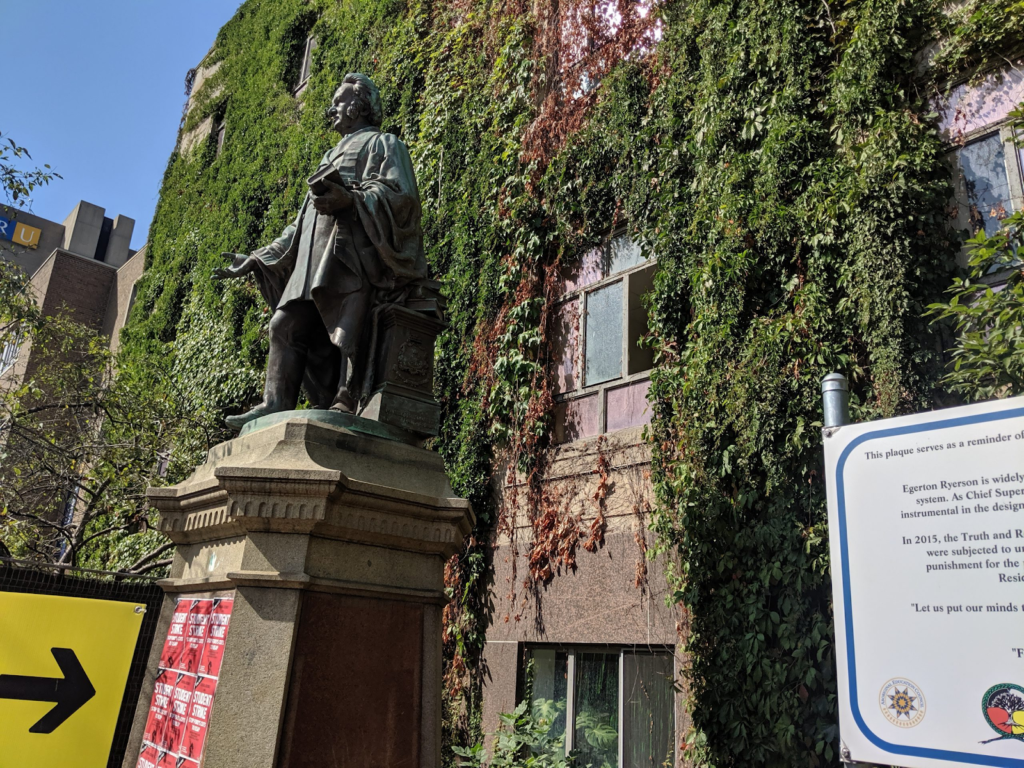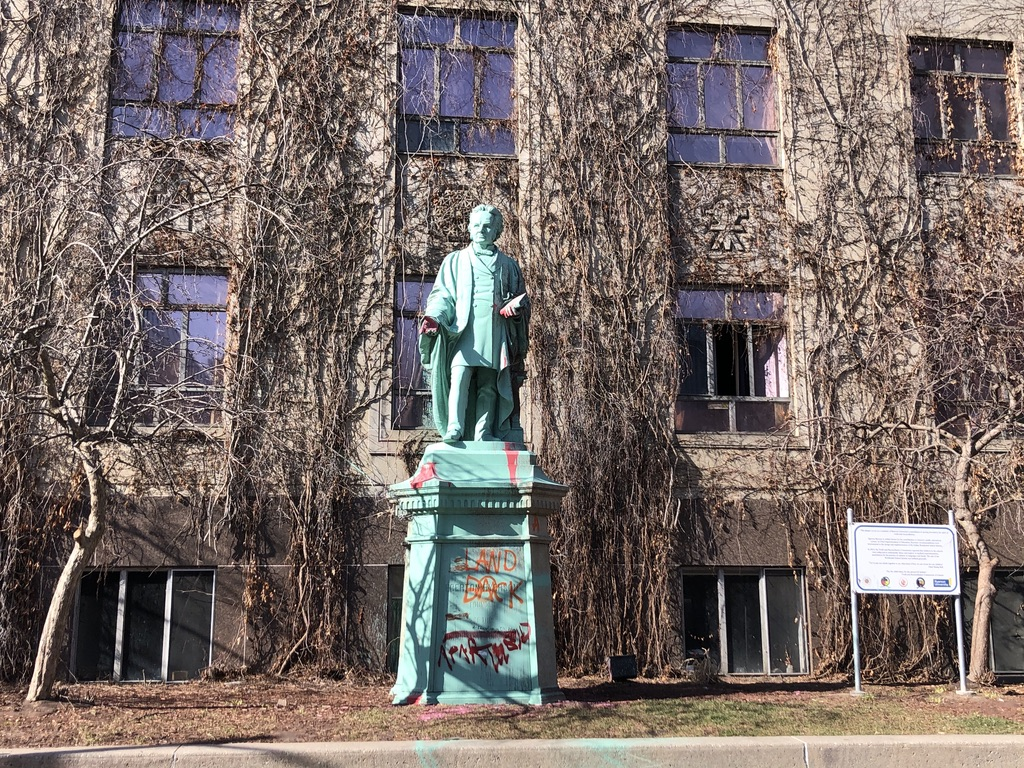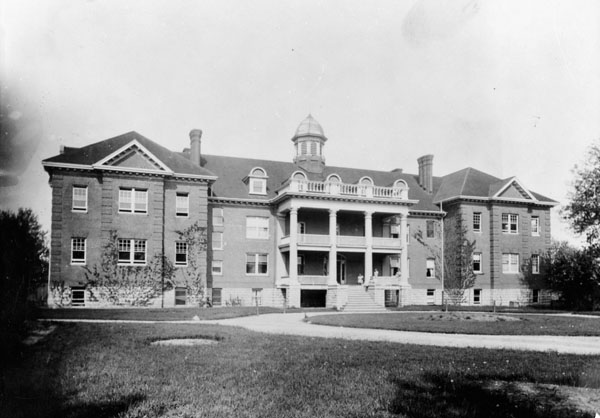Ryerson created a task force with the goal to reconcile the university’s colonial past. But its new name reveals problems with its inclusion of the broader Indigenous community.

Indigenous faculty have raised concerns about the renaming of a reconciliation task force at Ryerson, saying they felt excluded from the naming process which adopted a new name in Cree — a language with no connection to the Dish With One Spoon Treaty Territory, where the university sits.
The university recently announced the task force’s new name — Standing Strong, a spirit name. It’s also translated into Cree: Mash Koh Wee Kah Pooh Win. The task force, originally named the Egerton Ryerson Presidential Task Force, was launched to “reconcile the history of Egerton Ryerson” and to make recommendations regarding his statue on Gould Street.
However, some critics see the new name — given by co-chair Joanne Dallaire, a longtime campus Elder and senior adviser in Indigenous relations and reconciliation — as evidence of a lack of consultation with Indigenous faculty. Some feel like the task force is already falling short of its intended reconciliatory purpose.
“When you’re excluded so much and when you’re erased as an Indigenous person, sometimes it just becomes easier to not react and not to get involved,” said Lynn Lavallée, the strategic lead of Indigenous resurgence in the community services faculty, who is also Anishinaabe and registered with the Metis Nation of Ontario.
An Indigenous scholar outside of the Ryerson community recently reached out to Lavallée and asked her if she had played a part in the task force’s new name. They were probably wondering why the committee named it using Cree, Lavallée said.
“It’s kind of embarrassing, to be honest, to respond to community and say, ‘Well, no, I didn’t have a say at all,’” she said.
The task force was created as a public response to protests last summer, including a Black Lives Matter protest that ended with the pink paint vandalism of the Egerton Ryerson statue, which resides in the heart of campus. Ryerson’s historical ties to the residential school system — a marker of cultural genocide and abuse that systematically forced Indigenous children from their parents’ homes into boarding schools to be assimilated into Euro-Canadian culture — have left many questioning why his commemoration on campus persists.
But Indigenous faculty members interviewed by the Ryersonian say the task force’s new name is problematic. Some questioned the merit and validity of a spirit name for a university project, while others raised concerns about the exclusion of local Indigenous nations and languages. The consensus is that there hasn’t been enough consultation on the creation of the task force itself. Of the task force’s 14 members, only five, including Dallaire, identify as Indigenous.
“My immediate reaction was that this is inappropriate,” said Hayden King, the executive director of the Yellowhead Institute, who is Anishinaabe from Beausoleil First Nation on Gchi’mnissing in Huronia, Ont., about the use of a spirit name.
There are currently 29 Indigenous tenure-track faculty who could have lent their voice to the decision around the name, Lavallée said — many of whom were specifically hired as part of the university’s attempts at reconciliation. She hopes they will be consulted moving forward.

The name “Standing Strong” came to Dallaire, a Shadow Hawk Woman of the Wolf Clan who is Cree Omushkego with ancestry from Attawapiskat, Ont., during a traditional ceremony at home, she said. Dallaire and co-chair Catherine Ellis, who also chairs the university’s history department but is not Indigenous, said they sought out a spirit name to “centre” the task force and to guide its members.
But “spirit names are given to beings with a spirit,” said Eva Jewell, an associate fellow at the Yellowhead Institute and Anishinaabekwe from Deshkan Ziibiing (Chippewas of the Thames First Nation), and that only comes after “careful reflection, petition and ceremony.”
The co-chairs hoped that incorporating a spirit name into the task force’s work would represent a step towards greater awareness and recognition of Indigenous worldviews at Ryerson.
“Recognizing Indigenous traditions and cultures can help Canadian institutions reconcile with Indigenous peoples,” they said in a joint email. “This is something that is echoed throughout the 2015 Truth and Reconciliation Commission report.”
It’s not uncommon for projects to be given spirit names, Lavallée said, but she emphasized the importance of the process to reach that spirit name.
“We do it in our research projects,” Lavallée said. “You give tobacco … to a ceremonialist or traditional knowledge holder or healer and then they do ceremony and the name comes to them in spirit.”
In mainstream Canadian society, ceremonial practices are poorly understood and often misrepresented, Jewell said, so giving the task force a spirit name further decontextualizes Indigenous social practices.
“People are going to have different opinions on whether or not ceremony has a place in a university setting — I don’t believe that it does,” said King. “To create a ‘spirit name,’ and give that to a mostly non-Indigenous university committee — that sort of trivializes our ceremonies.”
Jewell emphasized the importance of using local nations’ languages in naming Indigenous-led movements, actions or organizations within the university community.
The name “Mash Koh Wee Kah Pooh Win” does not use conventional Cree spelling, but English spelling, she said. As a result, Jewell said, the name does not accurately convey Indigenous culture to a university community — especially one that is still learning about the diversity and intricacy of Indigenous worldview and thought.
Translating the name to the languages of the Haudenosaunee and Anishinaabe would have been more inclusive to the Indigenous community at Ryerson, Lavallée said.
“When we do a land acknowledgement, we acknowledge the stewards of the land, we acknowledge the treaties, we acknowledge the people,” she said. “Even Ryerson’s land acknowledgement doesn’t talk about the Cree because the Cree were more north.”
Ryerson University sits on Michi Saagiig Nishnaabeg territory — a space shared with the Haudenosaunee through the Dish with One Spoon Treaty, said Damien Lee, the Canada Research Chair in Biskaabiiyang and Indigenous Political Resurgence, and an associate fellow at the Yellowhead Institute.
“While Toronto is home to many Indigneous individuals from many nations, it is still Nishnaabe territory,” Lee said. “Nishinaabe and Haudenosaunee presence should be given priority in how Ryerson represents Indigenous initiatives on campus.”
The words and spelling used in the name’s Cree translation, “Mash Koh Wee Kah Pooh Win,” were unfamiliar to King.
“In some ways that’s fine, we all come with our own languages,” he said. “But when applied to a universitywide initiative, it will be seen to represent the Indigenous community as a whole. I didn’t have a say in this and neither did other Indigenous faculty I spoke to. So who was this naming really for?”
King said he commends the university for its commitment to making Indigenous issues part of its academic plan — including the creation of the Yellowhead Institute — and for its desire to address marginalization of Indigenous people.
But, he said, the naming is the latest indication that some Indigenous people, himself included, and the university may disagree on what reconciliation looks like.
The debate surrounding the task force’s name has highlighted the greater need for Indigenous community members’ voices to be given priority.
The university recently announced a community engagement process which will end on May 16. The task force wants to hear from as many members of the Ryerson and downtown Toronto community as possible, said Dallaire, and will be reaching out to all Indigenous faculty, staff and students.
Community members are able to use a community toolkit and a survey to submit feedback for the task force. Input from all of those participating will be compiled in the final report to the president, Dallaire said, although she cautioned it’s too early to say what the task force’s recommendations will be.
“If part of the final report is that there’s a recommendation to remove the statue or to change the name of the university, that will be in that report,” Dallaire said.
People are welcome to join the task force’s next online community presentation on April 8.
As much as Lavallee sees the name as yet another misstep, she still thinks it’s important not to lose sight of why the task force was created. Memorializing Egerton Ryerson has been a point of contention at the university for more than 10 years, Lavallée said, and “The time is now to remove the statue and change the name.”
Ryerson was a key architect in the design of the residential school system in Canada. The schools were “badly constructed, poorly maintained, overcrowded, unsanitary fire traps,” where children were fed poor diets, given substandard education and worked too hard, details the 2015 Truth and Reconciliation Commission report. Children were neglected, making them vulnerable to abuse — physical, emotional and sexual — and died “in tragically high numbers.” The last of Canada’s 139 residential schools finally closed in 1996.
Every time fourth-year politics and governance student Jeremie Caribou walks past the Ryerson statue outside the Kerr Quad on Gould Street, he said he experiences “physical and spiritual loss.”
Caribou is a member of the Indigenous Students’ Association and is half Nehithew and Mohawk from Pukatawagan, situated on the Mississippi in northwestern Manitoba.
“It’s important not to erase history,” he said, “but what’s more important is not to celebrate racism, oppression and genocide.”

Throughout the consultative process, the Standing Strong task force will also oversee an in-depth research project regarding the history of Egerton Ryerson and his relationship with Indigenous peoples, Ellis said. It is hearing from experts on topics including commemoration, reconciliation, public art and the history of Egerton Ryerson and the university.
As a historian, Ellis said she’s well aware of the “long shadow that the past has over the present” and said Standing Strong is holding conversations “both to acknowledge our colonial past and to advance toward a future of reconciliation.”
“We know there are many different views on the statue and on Egerton Ryerson’s history and legacy,” she said. “That’s why we need to hear from as many people as possible.”
President Mohamed Lachemi told the Ryersonian he believes it’s important to consult a wide variety of people as part of the task force’s process, which ends on May 16, because “Egerton Ryerson also has a history of being the father of the education system” in Ontario and in Canada.
According to the Canadian Encyclopedia, Ryerson’s work contributed to the foundations of the country’s present-day educational system, with the establishment of a “free, universal, nonsectarian and compulsory school system.”
Using Ryerson’s name for the university commemorates an individual who “actively advocated for Indigenous genocide and the segregation of Black people in Canada,” said Jewell, adding that the name is a colonial legacy rooted in the celebration of violence against those peoples.
Last summer, a petition for the statue’s removal garnered nearly 10,000 signatures after it was defaced. Hundreds signed a letter to Lachemi penned by the Continuing Education Students’ Association of Ryerson (CESAR) — including nearly a hundred professors and faculty members.
In 2017, The Ryerson Students’ Union, the Indigenous Students’ Association and CESAR demanded Ryerson remove the statue and change the university’s name, to which the university responded by installing a plaque next to the statue, explaining Ryerson’s role in residential schools. But critics considered the move to be inadequate, and calls for the statue’s removal have persisted.
“They’ve tried to respond when there’s been … protest, but we keep on having people coming to protest because I don’t think the university is dealing with it in a substantial way,” Lavallée said.
The administration is keen on having open discussions, building on past research and conducting an innovative consultation and research process, Lachemi told the Ryersonian. But he said it’s too soon to determine if the process will result in concrete change regarding the university’s name or the statue.
For now, he said: “Everything is on the table.”
